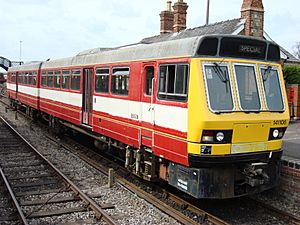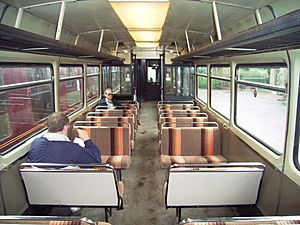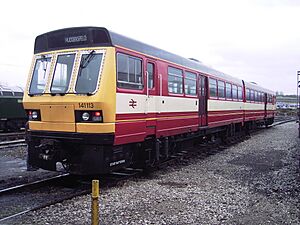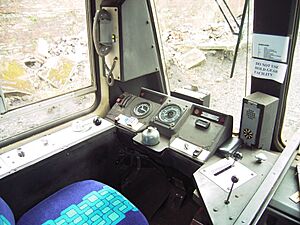British Rail Class 141 facts for kids
Quick facts for kids British Rail Class 141 Pacer |
|
|---|---|

141108 at the Colne Valley Railway
|
|

Interior of a Class 141.
|
|
| In service | 1984 - 2005 |
| Manufacturer | British Leyland |
| Order no. |
|
| Family name | Pacer |
| Refurbishment | 1988 - 1989 |
| Formation |
|
| Diagram |
|
| Fleet numbers |
|
| Capacity |
|
| Operator(s) |
|
| Depot(s) | Neville Hill |
| Line(s) served | West Yorkshire |
| Specifications | |
| Car body construction | Steel |
| Car length | 15.45 m (50.7 ft) |
| Width | 2.5 m (8 ft 2 in) |
| Height | 3.906 m (12.81 ft) |
| Articulated sections | 2 |
| Wheelbase | 9 m (30 ft) |
| Maximum speed | 75 mph (121 km/h) |
| Weight |
|
| Prime mover(s) | 1 × Leyland TL11 |
| Power output | 205 hp (153 kW) |
| Transmission | SCGR500 4-speed |
| Train heating |
|
| Bogies | AX1 |
| Braking system(s) | Air |
| Safety system(s) | AWS |
| Coupling system |
|
| Headlight type | Fluorescent |
| Track gauge | 1,435 mm (4 ft 8 1⁄2 in) standard gauge |
The British Rail Class 141 was a special type of train known as a Pacer. It was the very first Pacer model ever made! These trains were built because British Rail (the main train company in Britain back then) needed more trains quickly, but didn't have a lot of money to spend on fancy new ones.
So, they came up with a clever idea. A company called British Leyland had lots of bus bodies that weren't being used. The plan was to take these bus bodies and put them onto a simple train chassis, like the base of a freight wagon. This made the trains much cheaper to build.
However, because they were built like buses on train wheels, Pacers had a few quirks. They often had a bumpy ride because their suspension wasn't as good as regular trains. They could also be quite noisy when going around corners. This is due to something called "flanging," which is the squeaky sound you sometimes hear from train wheels. Because of these issues, Pacers were eventually replaced by newer, more comfortable trains. The Class 141s, in particular, have all been replaced.
Contents
What is a Pacer Train?

Pacer trains are a type of diesel multiple unit (DMU). This means they are trains that run on diesel fuel and have their own engines, so they don't need a separate locomotive to pull them. They were designed to be a low-cost solution for train travel in the 1980s.
Why Were Pacers Built?
In the 1980s, British Rail faced a challenge. Many of their older trains were getting worn out, and they needed new ones. However, building brand new, traditional trains was very expensive. To save money and get trains running quickly, they looked for a different approach.
The idea was to use parts that were already being made in large numbers. This led to the unique design of the Pacer trains.
Bus Bodies on Train Wheels
The most unusual thing about Pacers was how they were put together. They used the body of a bus, which was much lighter and cheaper to produce than a traditional train carriage. This bus body was then placed onto a simple, two-axle chassis, similar to what you might find under a freight wagon.
This design made them quick to build and very affordable. However, it also meant they didn't have the smooth ride of heavier, more complex trains.
Life and Service of the Class 141
The Class 141 Pacer trains started their service in 1984. They were mainly used in West Yorkshire, helping people travel around the region.
How Long Did They Last?
These trains served British Rail from 1984 until 1997. After that, some of them found a new life! A few Class 141s were sold to the Islamic Republic of Iran Railways and operated there from 2001 to 2005.
Refurbishment and Retirement
Between 1988 and 1989, the Class 141 trains went through a refurbishment. This means they were updated and improved to make them better for passengers. Despite these updates, they were eventually replaced by newer, more modern trains that offered a smoother and quieter ride.
Images for kids





